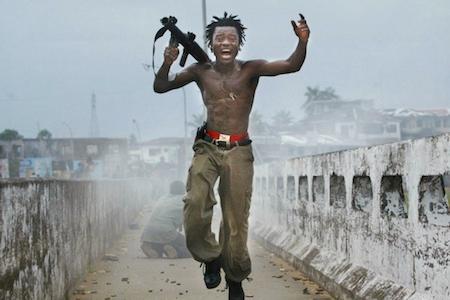‘Testament’ to One of World’s Most Dangerous Jobs
Published: Apr 21, 2014

This past Easter Sunday marked the third anniversary of the death of Chris Hondros, a Pulitzer Prize-nominated photojournalist who was killed in 2011 while on assignment in Libya. Hondros, who spent most of his career documenting war, took photographs that according to Mother Jones are “critically important in our understanding of what's going on in the world [and] critical in getting people to pay attention.”
Earlier this month, Powerhouse Books published a book of Hondros’ photos and essays entitled Testament, which includes Hondros’ coverage of conflicts in Kosovo, Afghanistan, the West Bank, Iraq, Liberia, Egypt, and Libya. The images in Testament include “a U.S. Marine removing Saddam Hussein’s portrait from an Iraqi classroom,” “American troops riding confidently in a thin-skinned unarmored Humvee during the first months of the Iraq war,” and “rambunctious Iraqi schoolgirls enjoying their precious few years of relative freedom before aging into more restricted adulthoods.”
For more than a decade, Hondros worked as a staff photographer for Getty Images, and it was his editors at Getty who put together Testament, combining Hondros’ “stunningly powerful and unforgettable” photographs with his equally powerful words. Here’s how a colleague and friend of Hondros recently described him in the New York Times:
Chris was much more than a photographer. He was a voracious reader of philosophy and history. He loved classical music. And he was constantly writing about his experiences. Anyone who spent more than five minutes with him learned what a great storyteller he was. His cadence was pitch perfect, capturing both the tragedy and the humor of the scene.
In addition to Testament, Hondros’ work will be featured in a forthcoming documentary film, the production costs for which were funded through a Kickstarter campaign (the campaign’s goal was $30,000; ultimately more than $89,000 was raised).
Further underscoring the importance of Hondros’ career—and perhaps serving as further inspiration to those who believe they might have the type of courage that Hondros did and are searching for careers of great meaning and global importance—here’s the CEO of Getty Images on Hondros’ life, death, and work:
We held a memorial for Chris in Brooklyn at the church where he was due to be married a few months later. There was a profound sense of loss — many of us still in a state of shock and disbelief. A couple of days later, we went to Chris’ hometown in North Carolina for his funeral. The contrast between the two places could not have been starker — busy, noisy, cosmopolitan Brooklyn and the small military town of Fayetteville. There was no difference, however, in the love, regard and esteem people felt for Chris ... People from all parts of the world and all walks of life mourned his death. Tributes came from the White House and the chairman of the Joint Chiefs of Staff, as well as from those who had known Chris since he was a child. They all recognised that the work Chris had chosen was important and that he was one of the best in the world.
To begin to get a sense of the gravity of Hondros' work, check out some of his images available here on the New York Times’ Lens blog. And make sure to enter “full screen” when viewing them.
Follow me @VaultFinance.
Read More:
The Dangerous, Harrowing Work of War Photographer Chris Hondros (Mother Jones)
The photographer who gave his life to tell the truth about Gaddafi's Libya (Guardian)
Finding Chris Hondros (NYT)
